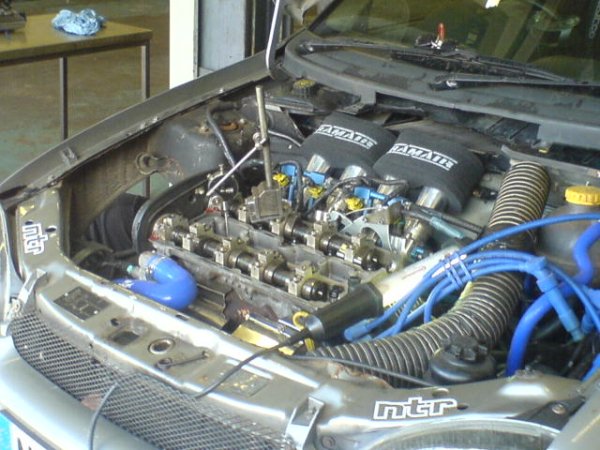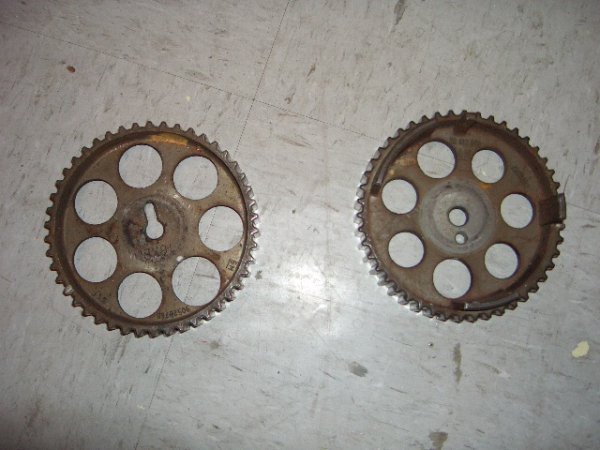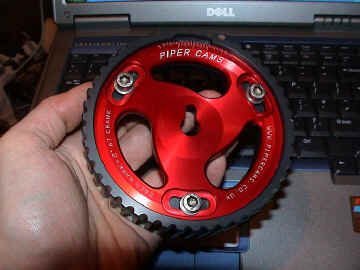Ste
Premium Member
 Registered: 5th Mar 03
Registered: 5th Mar 03
Location: Taif, Saudi Arabia
User status: Offline
|
Over the past 6 months there have been lots of threads on corsasport about fitting cams and I get lots of members sending u2u’s to me asking advice on fitting cams and gains that are achievable etc… hopefully the following will help people get a basic understanding about cams and how they work and why people fit different cams to gain performance.
Basically a cam is what opens and closes the valves. The valve is what controls how much air and fuel gets into the combustion chamber. The more air and fuel in the chamber, the bigger the bang, the bigger the power output of the engine.
The following is based on most engines but is aimed at the x14xe x16xe and c16xe
Performance cams are mainly different in 2 ways:
lift of the cam.
the higher the cam lift is, the more room there is for air and fuel to get into the engine.
duration of the cam
The longer the duration of the cam (measured in degrees) the longer the valve stays open, more air and fuel gets into the engine
Cams can be fitted to any engines, even standard. And you will get gains. But to make the most of them you cant just fit and forget about them. Heres why…
1. The point at which the spark ignites the fuel will not have changed. Commonly, fuel is ignited at what is called Top Dead Centre (tdc) tdc is the point when the piston is at its highest position in the bore. Because the cams you have fitted now open and close the valves at a different time than standard, the cam timing has changed and the air and fuel may not be entering the engine at the optimum time. How do you rectify this? Well its simple, you adjust the cam timing. And this is where the problems start.
2. Cam timing on standard cam pulleys can only be adjusted by advancing (turning the cam timing forward) or retarding (adjusting it backwards) by 1 tooth at a time. Cam timing needs to be precise, literally by 1 degree advance or retard you can lose or gain lots of performance. To overcome this Vernier cam pulleys are used. A vernier pulley allows the cam position to be adjusted because the toothed outer ring is separate to the centre that is bolted to the cam. Therefore minute adjustments can be made to cam timing.
Now by reading point no 1 above you will know that the cam timing needs to be set to a certain setting. (known as dialling in the cams) This setting is given by the cam manufacturer. This setting is achieved by setting piston no1 to tdc and then setting the position of the cam in comparison to that by using the manufacturers recommended setting. this setting is often described as ‘valve lift’. For example: a piper 264 cam requires 1.4mm of valve lift at tdc. How is this measured? Its measured by using dial gauges. One dial gauge is inserted down the spark plug hole of piston no1 to obtain tdc. Another is positioned on top of a cam follower. By measuring how far the cam follower moves from the valve being closed, to the optimum amount it is open or how far the valve has lifted (in this case optimum is 1.4mm) you can then set that cam. This position is usually the optimum point for performance. heres a photo of my cams being set using gauges:

By adding other modifications to the engine such as a mantzel inlet or throttle bodies the optimum cam timing can be different. For this to be adjusted to find the point at which the cam timing is producing the best performance the car can be put on a rolling road and have the cam timing adjusted to suit.
The gains that can be achieved with cams will vary massively with different engines and other modifications that have been carried out. To make the most of them the ecu should be re-mapped so that fuelling is adjusted to match the new cams otherwise the valves will be open for longer but no extra fuel will be injected into the engine unless the fuel map is adjusted to do so. Also, by re-mapping the ecu you can adjust the point at which the fuel is ignited (ignition timing). This is almost as important as the cam timing itself!
Unless you do all of the above, you will not make the most of the cams. If anything, the engine may run worse. Also worth noting is that you cannot fit vernier pulleys using a standard ecu, even a re-mapped one. The reason is that the ecu needs a signal from the cam position sensor that uses teeth on the exhaust pulley to tell the ecu the position of the cam. Vernier pulleys do not have these teeth so they cannot be fitted. Regal Autosports sell Dbilas pulleys which overcome this problem but I haven’t had any experience of them so I cant comment on how good they are.
standard pulleys:

vernier pulleys:

When chosing which cam to fit another thing to keep in ming is that the bigger the cam, the higher up the rev range the power will be achieved. If you already have a mantzel inlet, you will know that the power is already all between 4500 and 7000 rpm. Do you really want the power to be pushed further up again? Has the engine been strengthened using ARP conrod bolts and SBD metal cambelt rollers to allow the engine to cope with the higher revs? If so then you can raise the rev limit to match where the cams are now producing the power.
Then theres the cost. Heres a quick idea of how much cams could cost you when done properly:
Cams: £300
Verniers: £180
Setting the cams up: £120
Mapping: £120 (mappable management) or £450 )for a standard ecu to be re-mapped)
so there you go. its up to you to decide if its worth it, I fitted cams to my engine and gained 14 bhp but also need to use a 8500 rev limit to use the extra power. I would say that if you are using throttle bodies, do it. if you are using a mantzel type inlet, dont bother unless you have mappable management i.e standalone ecu such as Omex, DTA or Mbe etc...
There is a lot more to cams than Ive written above, this is just the basics! Ive kept it as simple as possible and there may be some mistakes as well so let me know what you think.
I would rather lose by a mile because i built my own car, than win by an inch because someone else built it for me.
|















